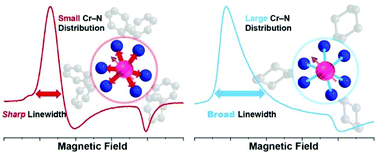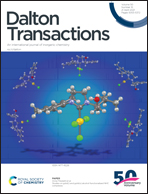Ligand control of low-frequency electron paramagnetic resonance linewidth in Cr(iii) complexes†
Abstract
Understanding how the ligand shell controls low-frequency electron paramagnetic resonance (EPR) spectroscopic properties of metal ions is essential if they are to be used in EPR-based bioimaging schemes. In this work, we probe how specific variations in the ligand structure impact L-band (ca. 1.3 GHz) EPR spectroscopic linewidths in the trichloride salts of five Cr(III) complexes: [Cr(RR-dphen)3]3+ (RR-dphen = (1R,2R)-(+)-diphenylethylenediamine, 1), [Cr(en)3]3+ (en = ethylenediamine, 2), [Cr(me-en)3]3+ (me-en = 1,2-diaminopropane, 3), [Cr(tn)3]3+ (tn = 1,3-diaminopropane, 4) [Cr(trans-chxn)3]3+ (trans-chxn = trans-(±)-1,2-diaminocyclohexane, 5). Spectral broadening varies in a nonintuitive manner across the series, showing the sharpest peaks for 1 and broadest for 5. Molecular dynamics simulations provide evidence that the broadening is correlated to rigidity in the inner coordination sphere and reflected in ligand-dependent distribution of Cr–N bond distances that can be found in frozen solution.



 Please wait while we load your content...
Please wait while we load your content...